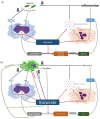How Staphylococcus aureus and Pseudomonas aeruginosa Hijack the Host Immune Response in the Context of Cystic Fibrosis
- PMID: 37047579
- PMCID: PMC10094765
- DOI: 10.3390/ijms24076609
How Staphylococcus aureus and Pseudomonas aeruginosa Hijack the Host Immune Response in the Context of Cystic Fibrosis
Abstract
Cystic fibrosis (CF) is a serious genetic disease that leads to premature death, mainly due to impaired lung function. CF lungs are characterized by ongoing inflammation, impaired immune response, and chronic bacterial colonization. Staphylococcus aureus (SA) and Pseudomonas aeruginosa (PA) are the two most predominant bacterial agents of these chronic infections. Both can colonize the lungs for years by developing host adaptation strategies. In this review, we examined the mechanisms by which SA and PA adapt to the host immune response. They are able to bypass the physical integrity of airway epithelia, evade recognition, and then modulate host immune cell proliferation. They also modulate the immune response by regulating cytokine production and by counteracting the activity of neutrophils and other immune cells. Inhibition of the immune response benefits not only the species that implements them but also other species present, and we therefore discuss how these mechanisms can promote the establishment of coinfections in CF lungs.
Keywords: P. aeruginosa; S. aureus; cystic fibrosis; immune response.
Conflict of interest statement
The authors declare no conflict of interest.
Figures


Similar articles
-
Genotypic and Phenotypic Diversity of Staphylococcus aureus Isolates from Cystic Fibrosis Patient Lung Infections and Their Interactions with Pseudomonas aeruginosa.mBio. 2020 Jun 23;11(3):e00735-20. doi: 10.1128/mBio.00735-20. mBio. 2020. PMID: 32576671 Free PMC article.
-
Exogenous Alginate Protects Staphylococcus aureus from Killing by Pseudomonas aeruginosa.J Bacteriol. 2020 Mar 26;202(8):e00559-19. doi: 10.1128/JB.00559-19. Print 2020 Mar 26. J Bacteriol. 2020. PMID: 31792010 Free PMC article.
-
Staphylococcus aureus and Pseudomonas aeruginosa Isolates from the Same Cystic Fibrosis Respiratory Sample Coexist in Coculture.Microbiol Spectr. 2022 Aug 31;10(4):e0097622. doi: 10.1128/spectrum.00976-22. Epub 2022 Jul 18. Microbiol Spectr. 2022. PMID: 35867391 Free PMC article.
-
Molecular Mechanisms of Staphylococcus and Pseudomonas Interactions in Cystic Fibrosis.Front Cell Infect Microbiol. 2022 Jan 6;11:824042. doi: 10.3389/fcimb.2021.824042. eCollection 2021. Front Cell Infect Microbiol. 2022. PMID: 35071057 Free PMC article. Review.
-
Airway epithelial control of Pseudomonas aeruginosa infection in cystic fibrosis.Trends Mol Med. 2008 Mar;14(3):120-33. doi: 10.1016/j.molmed.2008.01.002. Epub 2008 Feb 11. Trends Mol Med. 2008. PMID: 18262467 Free PMC article. Review.
Cited by
-
Modeling Pseudomonas aeruginosa-Staphylococcus aureus interactions in zebrafish to assess the host inflammatory response upon co-infection.Sci Rep. 2025 Jul 4;15(1):23965. doi: 10.1038/s41598-025-08459-4. Sci Rep. 2025. PMID: 40615487 Free PMC article.
-
Eisenia bicyclis-Mediated Gold Nanoparticles Exhibit Antibiofilm and Antivirulence Activities Against Pseudomonas aeruginosa and Staphylococcus aureus.Antibiotics (Basel). 2025 Feb 11;14(2):182. doi: 10.3390/antibiotics14020182. Antibiotics (Basel). 2025. PMID: 40001425 Free PMC article.
-
Biofilms in Periprosthetic Orthopedic Infections Seen through the Eyes of Neutrophils: How Can We Help Neutrophils?Int J Mol Sci. 2023 Nov 23;24(23):16669. doi: 10.3390/ijms242316669. Int J Mol Sci. 2023. PMID: 38068991 Free PMC article. Review.
-
Emerging Issues and Initial Insights into Bacterial Biofilms: From Orthopedic Infection to Metabolomics.Antibiotics (Basel). 2024 Feb 13;13(2):184. doi: 10.3390/antibiotics13020184. Antibiotics (Basel). 2024. PMID: 38391570 Free PMC article. Review.
References
-
- Cios K., Cohen B., Quittell L.M., Liu J., Larson E.L. Impact of Colonizing Organism in the Respiratory Tract on the Incidence, Duration, and Time between Subsequent Hospitalizations among Patients with Cystic Fibrosis. Am. J. Infect. Control. 2019;47:750–754. doi: 10.1016/j.ajic.2018.12.021. - DOI - PubMed
-
- Dehillotte C., Lemonnier L. Registre français de la mucoviscidose—Bilan des données 2021 Vaincre la Mucoviscidose Paris. 2022.
-
- Cystic Fibrosis Foundation Patient Registry 2021 Annual Data Report Bethesda, Maryland ©2022 Cystic Fibrosis Foundation. 2022.
Publication types
MeSH terms
Grants and funding
LinkOut - more resources
Full Text Sources
Medical

